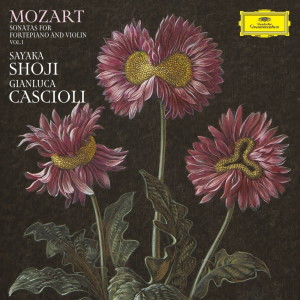
Wolfgang Amadeus Mozart (1756-1791)
Sonata for Violin and Piano in E Minor, K. 304
Sonata for Violin and Piano in G Major, K. 379
Sonata for Violin and Piano in A Major, K. 526
Sayaka Shoji (violin)
Gianluca Cascioli (fortepiano)
rec. 2022, Sala Ghislieri, Oratorio Santa Croce, Mondovi, Italy
DEUTSCHE GRAMMOPHON UCCG-9213 SACD [66]
This is Volume 1 of a projected series of Mozart Violin and Piano Sonatas by Japanese violinist Sayaka Shoji and Italian pianist Gianluca Cascioli. The two artists have been performing together for some time and have already recorded Beethoven’s Complete Sonatas for Piano and Violin for Deutsche Grammophon, which I had the pleasure of reviewing (review ~ review). In that cycle Cascioli performed on a modern concert grand. For the Mozart sonatas he plays a fortepiano.
It was during the pandemic that Sayaka Shoji took a closer look at performing Baroque Music, something she hadn’t really done since her student days at the Musikhochschule in Cologne. She had even experimented with the historical bow. “I ended up getting handmade plain gut strings, and a baroque bow as well as a classical bow”. The violin she uses here is strung with gut strings. She also plays with little or no vibrato.
I’m not in the know as to what instrument Cascioli uses in this recording, but I’m sure it was chosen for its bright tone and its well-regulated sonority. The fortepiano is the precursor of the modern piano. It has a lighter sound, and facilitates more staccato. This particular instrument has a wide range of timbres, resembling a harpsichord at times and a guitar at others. Cascioli’s mastery of it is second to none.
The pair have chosen three refreshingly attractive sonatas for this initial volume. The E minor Sonata K304 dates from Mozart’s stay in Paris in 1778. His mother had just died and the sonata reflects the sombre mood of the composer at the time, hence the minor key. It has two movements. The subdued bare octaves which usher in the first movement have a cold chill about them, reinforced by the vibrato-less violin. The movement is played with effortless simplicity and a distant starkness. The second movement is a Tempo di Menuetto, and conveys a sense of melancholy and depth of feeling.
Three years later in Vienna, Mozart composed his Sonata K379 in G major. It’s also cast in two movements. The first is an Adagio-Allegro, the second a Theme and Variations. The opening Adagio is one of the composer’s most beautiful creations, and the players savour the music’s ardent lyricism. The Allegro is agitated, and this performance is fully alive, sparkling and dramatic. The Theme and Variations are stylish and characterful.
The late three-movement Sonata for Violin and Piano in A Major, K. 526 was written in Vienna in 1787 and is structured on a much more substantial scale than the others on the disc. Two outer lively movements bookend a radiant Andante. This movement sounds like an intimate dialogue between violin and piano. The final Presto offers an opportunity for the pianist to shine and Cascioli acquits himself admirably, with some deft finger work brushing aside all technical difficulties.
What a joy to hear such lively, free-spirited accounts of these beautiful works. The rapport between Shoji and Cascioli is something wonderful to hear. The audio quality and balance have been perfectly captured by the DG engineers. My only minor gripe is that the booklet notes are in Japanese only. Perhaps DG would consider an English translation in their subsequent volumes.
Stephen Greenbank


















